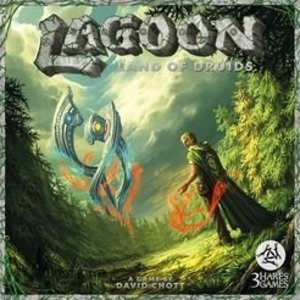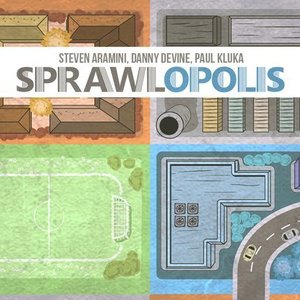
The Lost Expedition
Tabletop Game
Description from the publisher: Legendary explorer Percy Fawcett marched deep into the Amazon in...
Purple Phoenix Games (2266 KP) rated Lagoon: Land of Druids in Tabletop Games
Jun 12, 2019
Lagoon is a land of harmony and balance. Or at least it WAS until the rise of humanity. The three spiritual energies that once existed in a perfect equilibrium are now fighting for dominance and control over the destiny of Lagoon. Each energy has amassed a following of druids who are working to ensure that their chosen energy is victorious! Which energy will you choose to serve, and will your choice be the correct one in the end? There’s only one way to find out!
Lagoon: Land of the Druids is a game of tile placement and exploration. You are the leader of a circle of druids, and they will do your bidding throughout the game. On your turn, you will take any/all of these five actions: Move, Summon (add one of your reserve druids to the play area), Explore (add a new site tile to the table), Invoke (use a Site Action), or Unravel (remove a site tile from play). You can perform as many of these actions as you want, as long as you have the appropriate resources to spend. Each tile in the game is double-sided, and each side has a unique action/ability associated with it. Strategy is everything – which tile side should you choose to bring into play, and how can you best use the available abilities to benefit your chosen energy? You also have to keep an eye on your opponents because they might be trying to undermine your plans to help their energy achieve success! The game ends when all tiles have been explored, and then players count up points dependent upon which energy was ultimately dominant. The player with the most points is the winner!
As a solo game, Lagoon plays similarly to the multi-player game. Instead of competing against other humans, you are playing against an AI opponent (fondly referred to as “AJ” in the rulebook). On its turn, alternating with yours, the AI executes three steps – Explore, Unravel, and Invoke (perform an action dependent on which druids the AI currently has in play). Each of those steps is explained in more detail in the rulebook. The game ends as in a normal group game, and the player (either you or the AI) with the highest score wins.
The first thing I should mention are the solo rules themselves – they are very wordy and contain lots of ambiguity. It took me a couple of read-throughs before I felt comfortable trying to play, and even now I still keep the solo rules easily accessible when I do play. With so many moving elements in this game, clear and concise rules are necessary for an unencumbered game.
When I say there are a lot of moving elements, I mean it. At any point, you could have up to 5 druids in play, with access to up to 5 unique site powers to invoke in addition to the basic actions you can take on your turn. And on top of that, your druids are spiritually connected, so a druid on one site can use the power of a different site as long as you have a druid there as well. There are also lots of opportunities to combo powers this way, and unless you’re 100% focused, you could lose track of what you already did or forget to pay for an action. And in a solo game, you’re not only tracking this for yourself, you also have to make sure you’re executing the AI turns correctly. There’s just a lot going on and it can be easy to accidentally skip a step.
The thing I dislike most about playing Lagoon solo is that I have to make decisions for the AI. When placing tiles on AI turns, I get to choose which side to play. When the AI unravels a site, I get to choose which site to remove. It’s hard to play this game honestly because I can just choose whatever will benefit ME the most, and not necessarily act in the AI’s best interest. Obviously, a human opponent would do whatever they want for themselves, but in a solo game I am in control of my opponent. The rulebook does offer ways to alleviate this, but I either honestly forget to refer back to the rules for certain situations, or I just choose to ignore the suggestions. I know, I know, that sounds like a personal problem. And I guess it is. I just don’t like the responsibility of having to play two competing sides because it is hard to stay honest. Since this game is so dependent on strategy and personal decisions, there is no good way for an AI opponent to be successful.
Lagoon: Land of the Druids is a complex game that requires more strategy than you think. That being said, I don’t like to play it solo. Each turn offers lots of opportunities, but so many options can be overwhelming. Having to make decisions for the AI is not enjoyable for me because I am aware that I do not always make the best decision for the AI – it’s just hard for me to consciously make decisions detrimental to my game. The idea of this game is neat, but the execution of the solo rules (from their editing to their actual gameplay) just doesn’t work well for me. Give it a try solo if you want, but you’re not really missing a lot if you don’t.
https://purplephoenixgames.wordpress.com/2019/03/11/solo-chronicles-lagoon-land-of-the-druids/

Star Wars Battlefront Collector's Edition Guide
Book
The Star Wars battles you've always you've always dreamed of are here! Fight for the Rebels or the...

Easy Piano Tutorial - The Fun and Fast Way to Learn Songs on Piano
Music and Education
App
Tips and advice on learning how to play the piano for beginner, intermediate and advanced levels. A...

Potion Explosion
Games
App
The official adaptation of Potion Explosion, the award-winning puzzle board game. Play this game...
Purple Phoenix Games (2266 KP) rated Sprawlopolis in Tabletop Games
Jun 12, 2019
If you had the chance to design a city, how would you do it? Would you have a park on every block for some nice greenery, or do you think a large commercial district will bring in more people? What about housing – would people live right in the heart of the city, or would they live more on the outskirts? The day has finally come where those decisions are up to you! Well, mostly. You’ve been hired to help design the ultimate city! The city officials have given you some specific requirements, but beyond that, the plans are up to you! Can you meet their needs while also maximizing your space? It’s time to put your skills to the test and build the best city ever!
Sprawlopolis is a cooperative card placement game of only 18 cards. Given 3 random scoring conditions, you must draw and play cards into the city to fulfill those requirements. Meet or exceed their score, and you win the game! Fail to do so, and you have not succeeded in building the city up to specifications. Be careful how you decide to place your cards, however, because depending on the scoring conditions in play, certain placements could result in negative points at the end of the game. Working together, you and your team must decide which cards to play at what time to ensure that the requirements are all met. Solo play is identical to cooperative play, except that you just always have a hand of 3 cards from which to play. The score to beat each game is dependent on the scoring conditions, so this game isn’t just another beat-your-own-high-score game – you actually have a specific number in mind.
For a game with only 18 cards, there is a lot of variability in Sprawlopolis. I have yet to play 2 identical games. The layout of each card is unique, as are all of the scoring conditions, so the possibilities are endless… almost! I also enjoy playing this game solo because it requires a decent amount of strategy. Three things factor into your final score (the scoring conditions, block groupings, and roads) and it is impossible to succeed by focusing on only one of them. Your strategy is always changing based on the cards in your hand, and you really have to think about how to best utilize each card for maximum end-game points. Depending on when and where you play a card, it could change the entire city so you have to be thinking about the big picture, literally! And a neat thing about Sprawlopolis is that you can overlap cards. So maybe a card you played earlier is not really ideal anymore, given your current hand, so you can just cover up either a portion of it or the entire card!
The hardest thing about Sprawlopolis for me is that certain combinations of scoring conditions can be difficult to complete. One may give you points for a certain type of city block, but then another may take away as many, or more, points for that same type of city block. Or one gives you points for certain roads, but all roads result in negative points during end-game scoring. Since the scoring conditions are chosen randomly, there’s not really a way to negate this unless you just re-draw those cards. You usually can’t just look at a scoring condition combination and know if it will be difficult or not either – you just have to try it. I’m not saying they’re impossible necessarily, just harder to successfully complete.
Overall, I think Sprawlopolis is a neat game. It’s fast and easy to learn, yet strategic enough to keep you coming back for more games. I like to use it as a nice light filler game between some bigger games, or I just like to play it if I’ve got a quick 15 minutes to spare! Sprawlopolis is a fun game to play with a group, and it’s also a fun game to play solo. In my arsenal of solo games, it’s definitely one on standby.
https://purplephoenixgames.wordpress.com/2019/02/11/solo-chronicles-sprawlopolis/
Purple Phoenix Games (2266 KP) rated Villagers in Tabletop Games
Jan 16, 2020
Disclaimer: I do not intent to rehash the entire rulebook in this review, but rather provide an overview of the gameplay, and how it differs between multiplayer and solo play. -L
Villagers is a game of card drafting and tableau building in which players are competing to build the most prosperous village in the land. The game is played over a series of rounds, each broken up into the Draft Phase and the Build Phase. During the Draft Phase, players take turns drafting villagers from the available card stacks into their hands. During the Build Phase, players can add villagers from their hand to their tableau. Certain cards can be chained together, and provide more powers and/or end-game points – but they must be added to the village in chain order. At two points throughout the game, the First and Second Market Phases, all players will collect money depending on which cards they have in their villages. The game ends immediately after the Second Market Phase is completed, and the player with the most money is the winner!
As a solo game, Villagers plays very similarly to group play, with only a couple of differences. First, the solo player is battling against The Countess, an AI character, to create the best village. The Countess is incorporated into the game in a unique way. During the Draft Phase, whenever you draft a villager to your hand, you also select an available villager to go straight into the village of the Countess. The Build Phase is carried out as normal. At the end of every round, you blindly draw a face-down card from the Reserve (draw deck), and it automatically goes into the Countess’ village as well. The other twist to a solo game of Villagers is that there are Event cards in play each round. Events are resolved after the Build Phase, before beginning the next round, and are often detrimental to the player – like making you pay extra gold to unlock padlocks, for example. The First and Second Market Phases work the same as they do in a multiplayer game, and the game ends immediately after the Second Market Phase. If you have managed to accrue more money than the Countess, then you have won!
I want to start off by saying that I love Villagers. Card drafting and set collection are my JAM, and this is a game that highlights those really well without making it too complicated. Even when playing solo, those mechanics still feel balanced, and that makes the overall game enjoyable. From my previous Solo Chronicles, I have stated how much I dislike “Beat your own high score” solo modes, so I was extremely happy when I saw that Villagers pitted the solo player against an AI character – the Countess. For the most part, I think that the Countess works really well in this game. When you draft a card, the Countess gets a card as well. But the best part about that is that you get to choose which card goes to the Countess. That means that you are able to keep some semblance of strategy in your game, because you have the power to decide what cards go where, for the most part.
The other neat thing about solo play is the inclusion of Event cards in the game – which are not present in group play. The Events add an extra element that you have to take into account for the given round. Depending on the Event, it could compromise your strategy quite a bit, but that’s what keeps it interesting. You can’t just get into a groove and grind through the rounds, drafting everything you want, when you want. You have to adapt your strategy based upon the Event(s) in play, and the Countess’ village.
The only downside for me is that at the end of every round, the Countess gets the top face-down card from the Reserve, and depending on what card that is, it could throw a wrench into the strategy you’ve been working hard to set up. I guess that mimics a multiplayer game in a sense, though, because you can’t always control what your opponents will do. The biggest downside about solo play for me has nothing to do with actual gameplay, but rather table space. Every card that goes into the Countess’ village is a stand-alone, meaning that they do not chain together like cards in your village will. So depending on how long the game goes, the Countess’ village will get to be pretty large, and hog lots of the table. I think that just means I need a bigger table though…
All that being said – is Villagers a good game for solo play? I would say mostly yes. Strategy is still required for success, but adaptability of that strategy is what keeps the game engaging and entertaining. Nothing can quite replace the multiplayer experience, but playing against the AI character keeps the competitiveness alive in the game. As someone who does a lot of solo playing these days, I am glad that I have added Villagers to my collection. If you haven’t gotten a chance to play Villagers yet, I would highly recommend checking it out. Solo or multiplayer, it’s a great time!

Mercado Pago
Finance
App
Usa nuestra app para tus pagos de todos los días: • Recargar saldo en tu celular: ingresas el...

Words With Friends – Word Game
Games and Entertainment
App
The World’s Most Popular Mobile Word Game now has even more ways to play! Try new rewards and...

The Chase Australia
Games and Entertainment
App
It’s the dramatic new quiz show that’s got Australia gripped - now it’s your turn to face The...


